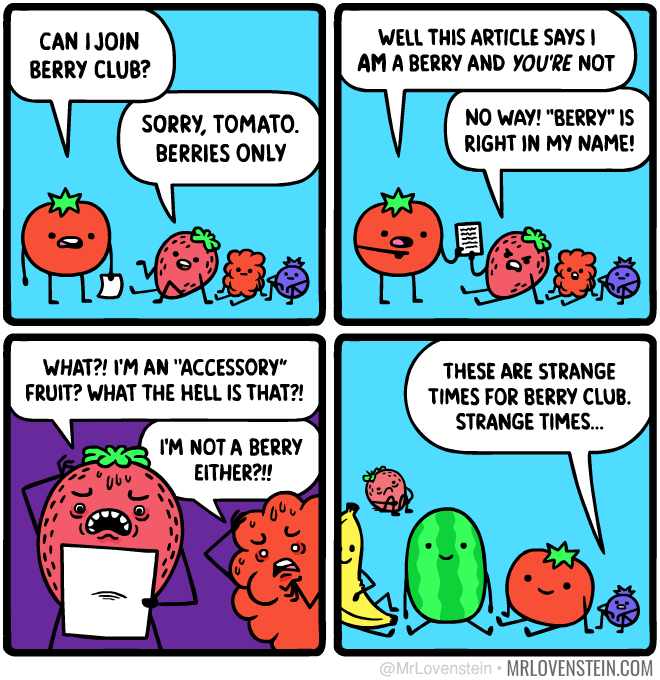Food Plant
Let’s not forget that apples, strawberries and cashews are pseudofruits, just like the produce of my labor!
Yeah but a mushroom’s such a fungi to be with.
He’s such a fun guy that there’s not mushroom to party.
knowledge is knowing that a tomato is a fruit. wisdom is taking that tomato, pureeing it into a sauce, and slathering it on a well done steak
and slathering it on a well done steak
Burn the heretic!
TBF, if your steak is well done, you’re probably gonna need some sauce since half the flavor has been cooked out of it.
My family always got well done at restaurants. Told me medium rare is for werewolves. No surprise they dumped brown sauce on it. My God what a revelation when I got medium the 1st time.
Or slicing it to throw on a mashed avocado for tasty guacamole
Mushrooms are obviously fruit
Mushrooms deserve their own kingdom
Yeah, fungi fruit. Mycelium is fungi vegeble
Fungi only got its own kingdom in 1969, before that they were a phylum in Plantae. There are tons of people still around who learned “mushrooms are plants” in school, so it’s not surprising downstream vocabulary hasn’t caught up.
Idk that food vernacular is necessarily downstream of rigorous taxonomies at all lol.

The whole fruit/vegetable controversy only comes because we’re trying to use two different domains of terms interchangeably: botanical terms and culinary terms.
Tomatoes (and squash, and pumpkins (which, side note, are a type of squash), and cucumbers) are botanically fruits, but culinarily they’re most commonly used as vegetables because they tend to be less sweet, particularly when raw. Mushrooms are botanically…well, I guess they’re botanically “n/a”, as they’re not a part of the plantae kingdom, but whatever–they’re typically considered botanical, so they’re “botanically” fungi, but culinarily they’re most commonly used as vegetables (or, interestingly, as meat replacements).
We get into the same linguistic confusion when we start throwing around “peanuts aren’t nuts, they’re legumes!”–botanically, yes, peanuts are legumes, but culinarily they’re most commonly used as nuts. See also: “green beans” are botanically pods, not beans, but we use them culinarily as vegetables; and many “berries” are botanically something else but we use them culinarily as berries; meaning they’re often left whole, mixed with other berries in the same dish, and go well with cream in cold summer desserts.
The whole thing is a misguided exercise in pedantry; “technically burritos aren’t sandwiches, they’re meat-sacks!” They’re both, and we instinctively understand that trying to compare the two terms is silly because “sandwich” is a culinary term and “sack” is not.
Another funny part of this is that pedants are trying to say that tomatoes are (botanically) fruits and not vegetables, but the closest thing to a definition we have for “vegetable” botanically is “literally all plant life and maybe also some fungi,” so tomatoes are clearly both fruit and vegetable botanically. Plus, they’re culinarily used as vegetables, but can also be used as fruits in some cakes, pies, sorbets, and so forth (and isn’t ketchup just a tomato smoothie?), so tomatoes are clearly both fruit and vegetable in culinary terms as well.
I am 100% with your well written explanation here!
Just one ‘nitpick’, that isn’t really even a nitpick because you did qualify the relevant part with ‘tend to be’:
A properly grown tomato absolutely can be so flavorful, sweet, tangy, varied, complex… that you could just eat it like an apple.
Not as sweet as most apples, but way, way more sweet than the typical mass produced tomato you’re likely to get in the US.
I’ve been to a few farmers markets where… a couple of smaller farms were growing just absolutely stellar quality tomatoes.
…
On the other hand, squash and zucchini, even the fancy ones from farmers markets?
Main difference I noticed was basically perfect ripeness, they still just taste like nothing.
(I guess I should also point out this was from 10ish years back, sadly, a lot of farmers markets now have a lot of people basically just reselling some particular, slightly higher quality but still mass produced fruits and veggies, than aren’t even local)
…
Finally, to throw more insanity on this terminology dumpster fire…
Corn.
Corn is arguably, from different domains of technical or colloquial meaning… a fruit, vegetable, and grain.
After millennia of us artifically selecting (and then just outright genetically engineering) what was originally, basically a kind of grass, we now have something that is now so sweet, that the US uses it to make HFCS, a cane sugar substitute… and then we jam that HFCS … into bread, soda, everything.
So… ketchup… is then roughly a tomato/corn smoothie, made primarily from two… frui-getables.
Yep.
Fruigetable.
You’re welcome, bwahahah!
Great post, with one caveat
the closest thing to a definition we have for “vegetable” botanically is “literally all plant life and maybe also some fungi,”
I got my degree in Ecology and Evolution, and we always used a similar working definition but it was “edible parts of a plant which are not fruit.” So basically botanically, stems, roots, leaves, flowers, and all subvarieties of those are vegetables. Fruits are fruits. Fungi are fungi.
good post, sounds like a copypasta
Alas, it’s all me. I…tend to be a bit verbose.
Oh–and thanks! I think that’s praise, at least.
It is a bit weird that we use some fruits as “vegetables”, like tomatoes and cucumbers. But, other fruits like mango or raspberry are so different from your typical “culinary vegetable” that you have to be very careful in how you use it in a savoury dish. There isn’t the same crossover for other edible plants. For example, I can’t think of any tuber that could sneak into a fruit salad unnoticed.
I guess it comes down to there being a lot more variety among fruits than other edible plant parts. Plus, humans have been tweaking edible plants for millennia. So, who knows, maybe the original cucumber was more “fruity”, but has been tuned over the years to be more “saladey”.
For example, I can’t think of any tuber that could sneak into a fruit salad unnoticed.
It’s not whole, but I can definitely imagine tapioca being used to thicken the juice for a fruit salad, and that comes from cassava, a tuber.
Definitely interesting. I wonder if there might also be a little bit to the fact that botanical fruits are basically just the best way to house seeds so that they’ll have some energy to grow when planted, which means that it’s independently evolved in a lot of different plants; so the culinary diversity of “fruits” is much greater.
Yeah, that seems likely to me too. Especially because some fruits are designed to appeal to animals who will eat the fruit and then poop out the seeds somewhere, and different fruits will appeal to different animals. A fruit “designed” to be spread by birds will be different to one “designed” to be spread by a hippo.
They’re (mushrooms) also constantly listed on American menus as a “protein” option despite a dire lack of the stuff
Hmm, is it really that little? The stats look devastating, like e.g. 3 grams per 100 grams, but mushrooms also consist out of 90+ grams of water.
For example, the button mushroom has:
100 g total - 91.8 g water - 1.7 g fiber = 6.5g nutrients
2.89 g protein / 6.5 g nutrients = 44.4% proteinComparing that to e.g. canned black beans:
100 g total - 70.8 g water - 6.69 g fiber = 22.51 g nutrients
6.91 g protein / 22.51 g nutrients = 30.9% proteinYes but you don’t dehydrate the food. And you’re not eating multiple kgs of mushrooms in a single sitting, which you would need to get anywhere close to the total amount of protein in other ‘protein’ options
TIL that I been deceived my entire life.
That’s because Vegetable is not a Botanical Term. It is a culinary term. So, Tomatoes are both fruit and vegetable.
This.
All fruits are vegetables. Not all vegetables are fruit.
The definition of a vegetable is just any edible part of a plant. While a fruit is specifically the seed-bearing ovary of a flowering plant.
Is that like an official definition for vegetables from some government? Because I don’t feel like there is a particularly good definition of vegetables. People mostly wouldn’t refer to apples as vegetables, for example.
Vegetables are edible parts of plants that are consumed by humans or other animals as food. This original meaning is still commonly used, and is applied to plants collectively to refer to all edible plant matter, including flowers, fruits, stems, leaves, roots, and seeds. An alternative definition is applied somewhat arbitrarily, often by culinary and cultural tradition; it may include savoury fruits such as tomatoes and courgettes, flowers such as broccoli, and seeds such as pulses, but exclude foods derived from some plants that are fruits, flowers, nuts, and cereal grains.
I wouldn’t call all cars a Honda Accord, either, but all Honda Accords are still cars.
The analogy doesn’t work. The apple is the narrow group, while vegetables are the wide group.
To make your analogy fit to the original statement it would be: “People mostly wouldn’t refer to a Honda Accord as a car”. Which is the opposite of what you are saying and it’s also not true, so it really doesn’t make any sense.
I don’t think you can just use two classification systems in the same sentence. It should probably be illegal or something
The true misconception is that there are scientific definitions and culinary definitions. No the culinary definitions don’t fit their scientific category. They’re not intended to.
Strawberries, blackberries, mulberries, and raspberries are not berries.
Bananas, aubergine (eggplants), oranges and grapes are berries.
Dangleberries aren’t real berries either.
what are strawberries and blackberries


I have the last pane spoken with an old man voice living in my head rent free for some reason
It’s alarming the rate at which it just pops up
maybe start demanding rent from the old man living in your head
He told me to get off his lawn and he’s keeping the ball.
It’s almost as if excluding due to arbitrarily drawn lines is a bad idea. It helps nothing, it only serves to hurt
peoplefood.
Pretty sure pumpkins are berries.
I don’t think I’ve ever considered a mushroom a vegetable, they’re just mushrooms
I believe, that’s mostly a US thing, where the government classifies them as vegetables…
deleted by creator
“Fruiting bodies,” even
I kinda don’t think they care



















